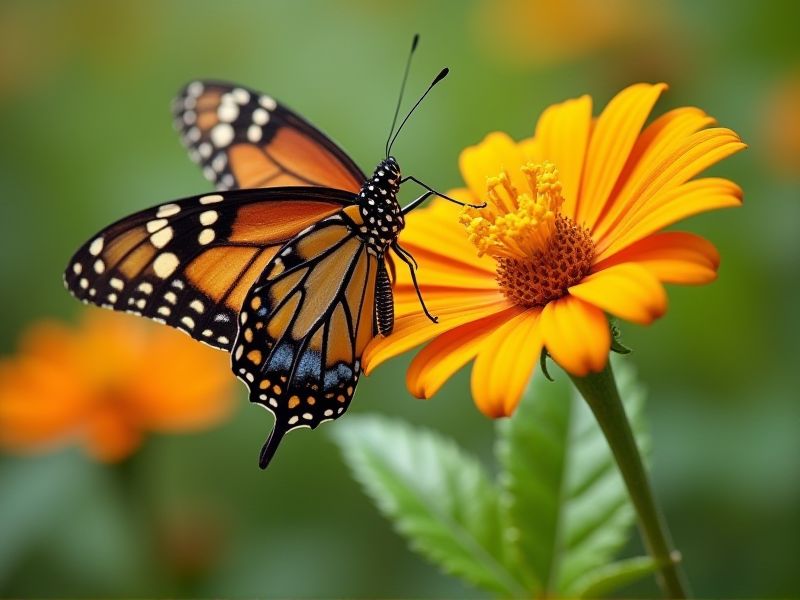
Butterfly garden plants that grow rapidly include milkweed, a crucial host plant for various butterfly species, especially monarchs. Another great option is lantana, known for its vibrant clusters that attract pollinators and bloom profusely throughout the season. Coneflower, with its sturdy stems and purple petals, provides both beauty and essential nectar for butterflies. Zinnias are also fast-growing favorites, offering a wide variety of colors while inviting butterflies to your garden. Planting these species ensures a lively and colorful space that supports butterfly populations and enhances your landscape.
List of some Butterfly garden plants that grow fast
- Milkweed (Asclepias)
- Coneflower (Echinacea)
- Black-eyed Susan (Rudbeckia)
- Lantana (Lantana camara)
- Bee Balm (Monarda)
- Zinnia (Zinnia elegans)
- Verbena (Verbena)
- Cosmos (Cosmos bipinnatus)
- Sage (Salvia)
- Pentas (Pentas lanceolata)
Important things about Butterfly garden plants that grow fast
Native Species Attract More Butterflies.
Creating a butterfly garden with native plants that grow quickly can significantly enhance your outdoor space. Consider incorporating species like milkweed, which not only flourishes rapidly but also serves as a crucial habitat for monarch caterpillars. Coneflowers are another excellent choice, known for their vibrant blooms and ability to attract a variety of butterflies. By selecting these fast-growing native plants, you ensure a thriving habitat that supports local butterfly populations and enriches your garden's biodiversity.
Fast-Growing Annuals Include Zinnias And Cosmos.
Fast-growing annuals such as zinnias and cosmos are ideal for your butterfly garden, attracting these vibrant insects with their bright colors and abundant nectar. Zinnias, available in various hues, bloom from summer until frost, providing a continuous food source for butterflies. Cosmos, known for their feathery foliage and daisy-like flowers, thrive in well-drained soil and also attract beneficial pollinators. By incorporating these plants into your butterfly garden, you can create a lively and colorful environment that supports local ecosystems.
Perennials Like Milkweed And Coneflower Thrive Quickly.
Perennials such as milkweed and coneflower are excellent choices for a butterfly garden due to their rapid growth and ability to attract various butterfly species. Milkweed, specifically, serves as a crucial host plant for monarch caterpillars, while coneflowers provide nectar that supports adult butterflies. Other fast-growing plants include black-eyed Susans and butterfly bush, which enhance the garden's aesthetic while fostering a vibrant ecosystem. Incorporating these plants not only promotes butterfly populations but also encourages pollinators, contributing to biodiversity in your garden.
Sunlight Requirement Is Crucial For Growth Speed.
Choosing butterfly garden plants that thrive in full sunlight can significantly enhance their growth speed. Popular options include milkweed, known for attracting monarchs, and lantana, which blooms vibrant flowers quickly. These plants not only flourish in sunny conditions but also provide essential nectar sources for butterflies throughout the growing season. By selecting species that are well-adapted to your local climate, you ensure a flourishing habitat that supports these beautiful pollinators effectively.
Nectar-Rich Flowers Are Essential For Attracting Butterflies.
Fast-growing butterfly garden plants, such as milkweed and lantana, provide abundant nectar that attracts a variety of butterfly species. Milkweed, particularly, is crucial for monarch caterpillars, offering both food and habitat. Lantana, with its vibrant clusters of flowers, not only draws in butterflies but also thrives in sunny, well-drained soil, making it a low-maintenance choice for your garden. Incorporating these plants will create a vibrant and dynamic environment that supports butterfly populations.
Foliage Plants Support Caterpillars And Their Growth.
Foliage plants such as milkweed, asters, and coneflowers are essential for creating a butterfly garden that nurtures caterpillars. These fast-growing plants provide not only food sources for caterpillars but also nectar for adult butterflies, fostering a thriving ecosystem. Incorporating diverse flowering species and host plants ensures your garden attracts various butterfly species, enhancing its vibrancy. By selecting plants that flourish in your local climate, you can create a sustainable environment that supports the entire butterfly life cycle.
Well-Drained Soil Enhances Growth Rates.
Choosing fast-growing plants for your butterfly garden can significantly attract more pollinators and enhance your outdoor space's vibrant colors. Plants such as milkweed, zinnias, and cone flowers thrive in well-drained soil, boosting their growth rates and providing essential nectar for butterflies. Consider incorporating native species, as they often adapt better to local soil conditions, ensuring a robust garden ecosystem. Regular watering and adequate sunlight will further optimize growth, creating a flourishing habitat for butterflies to thrive.
Watering Frequency Affects Plant Health And Speed.
In a butterfly garden, choosing fast-growing plants like Milkweed, Zinnias, and Marigolds is essential for attracting and sustaining butterfly populations. Proper watering frequency, typically set to every 2-3 days during dry spells, ensures these plants thrive and flourish. These vibrant flowers not only provide nectar but also serve as essential host plants for caterpillars, promoting a healthy lifecycle within your garden. Consistently maintaining moisture levels will help foster a lively environment, drawing in butterflies and improving your garden's overall biodiversity.
Companion Planting Can Boost Growth And Diversity.
Butterfly garden plants, such as milkweed, zinnias, and coneflowers, not only attract pollinators but also grow rapidly, enhancing your garden's biodiversity. Milkweed is essential for monarch larvae, providing food while establishing a vibrant ecosystem. Zinnias and coneflowers thrive in full sun, blooming continuously throughout the summer, ensuring a colorful display that entices butterflies. Incorporating these fast-growing species into your garden can create a dynamic habitat that supports both butterfly populations and overall plant diversity.
Regular Pruning Encourages Faster Bushy Growth.
Butterfly garden plants that grow fast include lantana, a vibrant flowering shrub known for attracting butterflies with its nectar-rich blooms. Milkweed, specifically Asclepias tuberosa, is another essential fast-growing plant that serves as a host for monarch caterpillars, ensuring a thriving butterfly population in your garden. Salvia, particularly Salvia guaranitica, boasts stunning blue flowers and a rapid growth rate, making it a magnet for various butterfly species. Regular pruning of these plants not only promotes bushy growth but also enhances their overall health, providing a lush habitat for butterflies to thrive.
